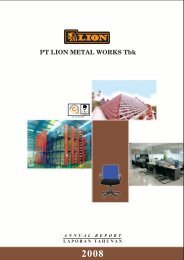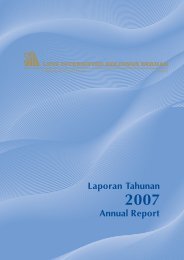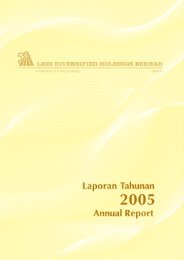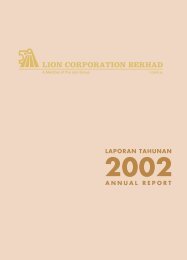Create successful ePaper yourself
Turn your PDF publications into a flip-book with our unique Google optimized e-Paper software.
13<br />
IMPROVEMENT DIVISION TIPS<br />
TYRE CARE & SAFETY<br />
<strong>The</strong> following are some basic information on tyre care and maintenance to obtain maximum tread life<br />
and performance from tyres to ensure maximum operational driving safety according to Silverstone<br />
Berhad.<br />
Inspect Your Tyres<br />
Periodically inspect your tyres for cuts, chips,<br />
embedded objects or unusual bulges, as a<br />
preventive measure to safeguard against<br />
sudden and unexpected tyre failure<br />
Ensure Sufficient Tread Depth<br />
When a tyre’s tread wears down to less than<br />
1.6mm, it should be replaced as soon as possible.<br />
Tyres have tread-wear indicators which appear<br />
across the grooves of the tread pattern when the<br />
1.6mm limit is reached<br />
Check Tyre Inflation Pressure<br />
Tyre Inflation pressures should be checked<br />
regularly when the tyres are cold. After checking,<br />
ensure that the valve caps are replaced as they<br />
provide secondary air seal to keep dirt and<br />
moisture out of the valve cores<br />
Rotate Your Tyres<br />
Regularly rotating your car’s tyres will help you<br />
achieve more uniform wear and longer overall<br />
tread life. Follow your vehicle owner’s manual<br />
recommendation or as a general guideline,<br />
rotate your tyres every 10,000km<br />
Avoid “Tyre Mixing”<br />
It is advisable to avoid mixing different tyre types<br />
due to varying construction. It is also dangerous<br />
to mix tyres of different sizes and aspect ratios<br />
Do Not Overload<br />
Tyres are designed to carry a specific maximum<br />
load. Do not exceed this maximum load as it can<br />
lead to premature tyre failure. <strong>The</strong> maximum<br />
load capacity can be found on the tyre sidewall<br />
Changing Tyre Sizes<br />
If you wish to change to a different rim or tyre<br />
size, it is best to consult your tyre technician as<br />
any change can affect your speedometer<br />
readings<br />
Reduce Speed During Rain<br />
When driving on wet roads, reduce your speed,<br />
as driving too fast can cause tyre to aquaplane<br />
(<strong>The</strong> tyre tread loses contact with the surface of<br />
the road due to a film of water)<br />
Maintain Correct Air Pressure<br />
An under-inflated tyre builds up excessive heat<br />
and results in unnecessary tyre stress and irregular<br />
wear. An over-inflated tyre wears excessively in<br />
the centre of the tread. Under-inflation and overinflation<br />
can result in premature tyre failure<br />
Spare Tyre<br />
Most cars today carry a space-saver tyre as a<br />
spare. This tyre should be used only to get to the<br />
nearest tyre outlet and should not be used over<br />
longer distances or speeds exceeding 80kph<br />
Check <strong>The</strong> Balancing<br />
If you experience excessive vibration transmitted<br />
from the tyres to the steering wheel, get a<br />
qualified technician to check the balancing as<br />
this can result in an uncomfortable ride and<br />
cause excessive mechanical stress on the<br />
suspension and steering systems<br />
Check <strong>The</strong> Alignment<br />
Hitting a pothole or kerb can affect your car’s<br />
alignment and result in uneven tyre wear. Have a<br />
qualified technician check the wheel alignment<br />
periodically to ensure that your car is properly<br />
aligned<br />
Tyres are the only parts of the vehicle which are in<br />
contact with the road; therefore safety in braking,<br />
steering, cornering and acceleration depends<br />
greatly on these four patches of rubber. It is highly<br />
recommended that the tyres on your vehicle be<br />
checked regularly and maintained in good<br />
condition to obtain economic and safe<br />
performance.
















